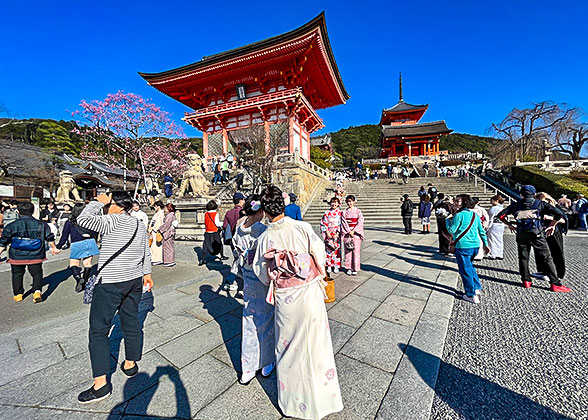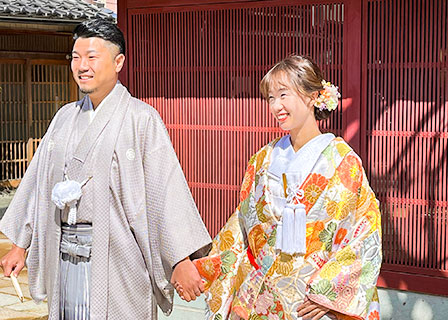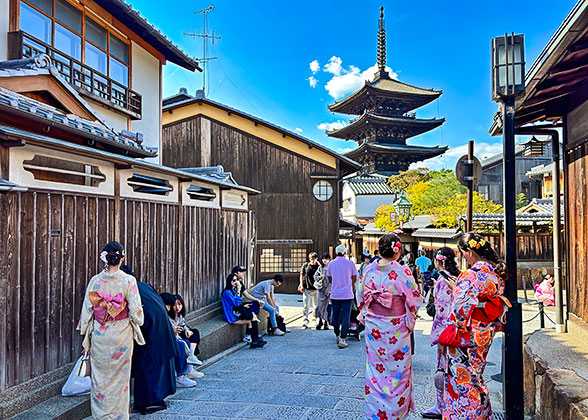Kiyomizu-dera Temple (Pure Water Temple)
Kiyomizu-dera Temple, or Pure Water Temple, nestling in the dense forest mid-way up a side of Mount Otowa in eastern Kyoto, is one of the most popular temples in Japan. It has a history dating as far back as to 778 AD, involving some tragic stories of being ravaged over ten times by fire. The buildings we see today are primarily the fruit of the restoration work in the 1600s. In 1994, Kiyomizu-dera was listed as a UNESCO World Heritage Site.

Kiyomizu-dera Temple Photos ( 86
|
Story Behind Kiyomizu-dera Temple
The core figure in the origin of the Kiyomizu-dera Temple is an ascetic monk named Kenshin. Inspired by an old man in his dream, he departed from Nara for north and walked until he met a crystal waterfall in Mount Otowa and another ascetic monk. This man turned out to be waiting for him, and disappeared after asking him to carve a statue of Kannon and establish a temple for the goddess. Having kept the sacred ground in peace for two years, Kenshin one day came across a deer hunter at the waterfall. Enlightened by Kenshin’s teachings, the hunter abandoned its slaughtering career and later assisted him in completing the construction of the temple. For the waterfall and its pureness, it’s named Kiyomizu-dera, meaning the temple of pure water.
Major Attractions in Kiyomizu-dera Temple
Nio-mon: The two-story main gate of Kiyomizu-dera Temple.
Sai-mon (West Gate): The west gate of the temple. Nicknamed “the gateway to Paradise”, it provides one of the best angles for a spectacular sunset.

Yasaka-no-to Pagoda
|
Hondo (Main Hall): In the north of the temple grounds, built onto the hillside, this magnificent building enshrines the statue of eleven-faced, thousand-armed Kannon Bodhisattva, which represents mercy and compassion, at its innermost sanctuary called nainaijin.
The most impressive part should be its iconic Kiyomizu Stage, a spacious veranda jutting out from the hall at 13 meters (43 feet) high. The stage was originally built for religious performances dedicated to the Kannon on special occasions. Although nowadays visitors flock here mainly to have a captivating view of Kyoto, its nature as a place of worship remains, as some of the performances are still given sometimes.
The temple also often appears in headlines as a man-made miracle built “without a single nail”, which is true as the whole structure is supported by pillars penetrated by rails without using nails. The ancient wisdom behind is really something to marvel at!

Hondo the Main Hall
|
Otowa No Taki (Otowa Waterfall): To the northeast of the main hall lies Otowa No Taki. Three separate trickles are channeled and flow out from the roof of a pavilion-like stone building, under which visitors can ladle and drink the water to bring themselves luck. It’s said the trickles grant different blessings, respectively on health, academic success, and romantic happiness. It is of an unrivaled significance in the temple, since not only the entire temple was built on this site, but also its name, Kiyomizu-dera, was derived from the pure waters of the fall.

Otowa Waterfall
|
Okuno-in Hall: Standing above the Otowa Waterfall, the hall has a similar raised veranda as that of the main hall and was constructed using the same traditional method. It also offers photogenic views of Kyoto. The nearby some 200 short stone sculptures of Jizo, a Shinto deity protecting children, are a mournful spectacle, since the bibs on them were worn by parents who lost their children.
|
|
|
Jojuin Garden: Lying to the west of the main hall is this beautiful Jojuin Garden, designed to fit the surrounding mountain landscape and serving as the administrative part of Kiyomizu-dera Temple. It was first built to house a priest who devoted himself to restoring the temple since it was destroyed by fire. Also named the Moon Garden, Jojuin has a magical appearance when shone by the moonlights. It’s open from Apr.29 to May 5 and from Nov. 18 to 30 for visitors to take in its tranquil beauty inside.
|
|
|
Fun Activities in Kiyomizu-dera Temple
![]() View a fascinatingly different Kyoto from the overhanging veranda of the main hall.
View a fascinatingly different Kyoto from the overhanging veranda of the main hall.
|
|
|
|
Limited Periods |
Events |
|
Jan. 1 – 7
6:00 am – 6:00 pm |
Shusho-e, New Year's Day Service held in nainaijin of the mail hall; visitors can pray and have their forehead stamped to avoid evil
Feb. 15
|
|
Feb. 15 |
Nehan-e, a memorial service held to remember the day when Shakyamuni reached Nirvana |
|
Mar. 15
2:00 pm - 3:30 pm
|
Seiryu-e, a tribute to the Japanese god Blue Dragon that brings prosperity |
|
Mar. 25 - Apr. 2
Until 9:30 pm
(Last entry until 9:00 pm)
|
Night viewing of illuminated cherry blossoms |
|
Apr. 3
2:00 pm - 3:30 pm
|
Seiryu-e |
|
Apr.29 – May 5
9:00 am – 4:00 pm (Last entry)
|
Special viewing of Jojuin garden |
|
Aug. 9 - 16
From Aug. 9 to 13: 9:00 am - 5:00 pm (Last entry); from Aug. 14 to 16: 9:00 am - 9:00 pm (Last entry) |
Thousand-day Pilgrimage; special visit of Kannon in the nainaijin of the main hall |
|
Sep. 15
2:00 pm - 3:30 pm
|
Seiryu-e |
|
Nov. 18 - 30
Until 9:30 pm
(Last entry until 9:00 pm)
|
Night viewing of illuminated maple leaves |
|
Nov. 18 - 30
9:00 am- 4:00 pm (Last entry);
6:00 pm - 8:30 pm (Last entry)
|
Special viewing of Jojuin garden |
Opening Hours and Entrance Fee
Opening Hours: 6:00 am – 6:00 pm; 6:00 am – 6:30 pm in July & August; 6:00 am - 9:30 pm on days for night viewings.Entrance fee: 400 yen / per adult
How to Get There?
From JR Kyoto Station or Keihan Shichijo Station: Take City Bus No. 206 / No. 100 to Gojozaka Bus Stop and reach the temple gate after 10 minutes’ walk uphill. If you set out on Saturdays and holidays, you can take Kyoto Bus No. 18 to the said stop.From Keihan Kiyomizu Gojo Station: Walk 25 minutes or so to the temple.
From Hankyu Kyoto-Kawaramachi Station and Keihan Gion Shijo Station: Take City Bus No. 207, get off at Kiyomizu-michi Stop, and go on a 10-minute walk southeast.
Nearby Don't-Miss Attractions

Sannenzaka and Ninenzaka
|
The approach to the Kiyomizu-dera Temple to the northeast, these gently sloping lanes are lined with old wooden houses now serving as ryokan inns, shops, cafes, and art studios, giving off a thick ancient vibe to experience.
Gion area, the origin of the Geisha culture, is where to encounter those mysterious female artists. The Edo-era vibe of 200 years ago is well-preserved here, for the geishas and traditional buildings flanking the streets. The Ninenzaka street leads to Gion.
Having survived some 860 years of history, Sanjusangendo is the longest wooden structure in the world. The 1,001 human-size statues of Kannon Bodhisattva the temple boasts is a spectacle to behold.
Kiyomizu-dera Temple Photos & more Kyoto Photos





